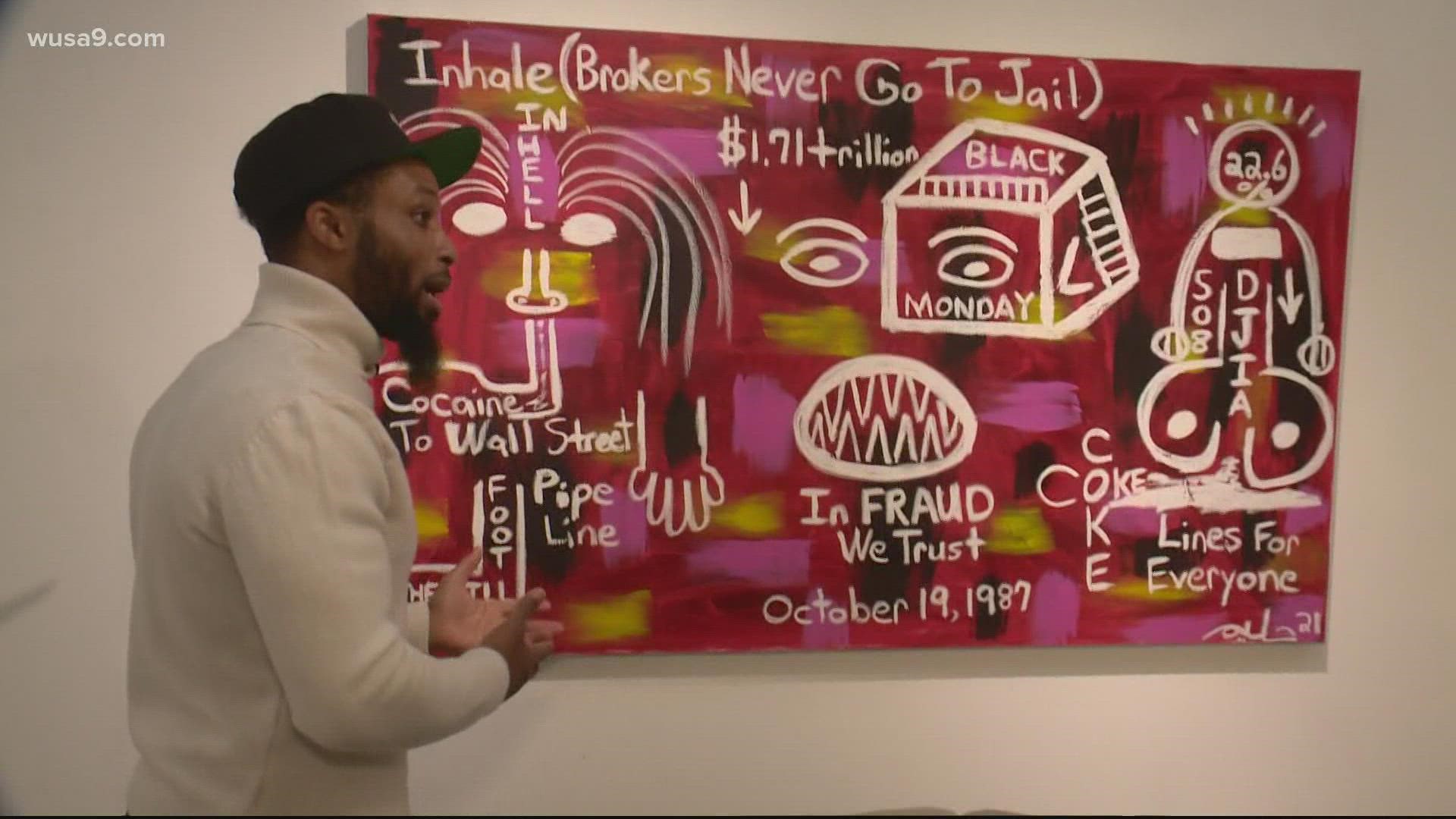WASHINGTON D.C., DC — Halim Flowers has a uniquely D.C. story. The 41-year-old was one of the brainy kids in a neighborhood where book smarts were the subject of ridicule.
That environment offers two choices: Lean into the books and chart your own path or go with the flow and eventually follow your friends and classmates down a pipeline of drugs, violence and prison.
As a teen, Flowers chose the latter. The choice led him to prison. He was incarcerated from the age of 16 until he turned 38.
His crime and punishment story is covered vividly through this DCist article, but while his back story is intriguing, it’s not what makes his art interesting and exciting.
“You have this cocaine to Wall Street pipeline," Flowers explains as he points to one of his recent works. "But when it comes to us, it’s the school to prison pipeline.”
The lens through which Flowers sees the world and how he offers social commentary through his paintings is incredibly unique and notably absent from a lot of celebrated modern art.
Flower's art leaps off the walls in rooms filled with artists like Salvador Dali, Pablo Picasso and Andy Warhol.
"Each picture is a book within itself," Flowers said, highlighting a few of his works for our cameras. "This is a book about cryptocurrency and financial literacy. Wall Street and the SEC. This is about children and music. A picture should be worth a thousand words and maybe more.”
Why is Flower's art unique? Because he’s not like any artist you know. A poor kid growing up in the Kingman Park neighborhood of Northeast D.C. who was intellectually gifted – but folded in with the wrong crowd, because that’s who was cool in his neighborhood.
"I’m a nerd. I’m a self-professed nerd. I grew up in a community where even though I took my PSAT’s at 11 and I was taking classes at Howard University when I was 11, it wasn’t a community that celebrated intelligence," said Flowers. "It didn’t celebrate creativity. It was a community that was steeped in poverty and it celebrated materialism."
He likens his prison experience to a monastery; an intellectual immersive experience without the distractions of drugs, alcohol or women.
Society labels him as a hardened criminal – yet he came out more educated than a lot of free men will ever be.
So, why was he so lucky to defy rates of recidivation? It wasn’t luck. He had a plan of action to build upon since the day he got out of prison. He’s run at full speed ever since to try and achieve his goals.
"I knew that I would be in the literature and the arts, I just never thought I’d be painting," Flowers said. "I didn’t start painting until the quarantine in March of 2020. It’s a blessing. When your rising from a bottomless pit, how can you fall?"
It's quite a leap for a kid from Northeast who was tossed aside and left for dead by the criminal justice system to now be a major force in modern art on display along Pennsylvania Avenue, D.C.'s hallowed boulevard that hosts America's political power structure.
“My wife and I were walking to the Kennedy Center for our anniversary,” said Flowers. “We walked past this place. Walked in and I said I’m an artist too. She (Gallery Director Jennie Buehler) did a studio visit. The owner flew down and met me and the rest is history.”
Flowers made the most of his time behind bars. He had a subscription to the Wall Street Journal. He pursued collegiate studies in finance and economics.
He tapped into this almost Andy Dufresne-esque mindset that although prison was destined to affect him, it wasn't going to change or define him. He chalks that up to having the right role models at the right times. That's what makes his situation unique to other DC youngsters who end up behind bars.
"Very rarely do the children from my community where I grew up have people who do not come from their social-economic background to love them, to believe in them and to invest in them," said Flowers.
"When you don’t have that type of investment, the only thing you can be is what you see going on in your environment," said Flowers. "And if your immediate environment in your household is intergenerational poverty and illiteracy then that’s all you can articulate."
Flowers has published eleven books. He’s extremely well-read, reciting authors and books, philosophers and educators as if they were friends waiting in the next room.
As someone with a clear finger on the pulse of society, even when locked up, there wasn't much that surprised him as he effortlessly assimilated back into society. Except for one thing. He described being confounded at how people, in general, seemed miserable and depressed.
"I have nothing but love in my heart," Flowers told me at several points throughout our discussion.
His art channels that love. Even though navigating heavy topics like class warfare, systemic racism and criminal justice reform can drip with resentment, frustration and anger --- there's a relentless optimism in his art that parallels his life story: you can dare to dream and be an agent of change if you don't let life distract you from pursuing your goals.
Click HERE for Halim's Instagram page.
Click HERE for more on the DTR Modern Galleries.

